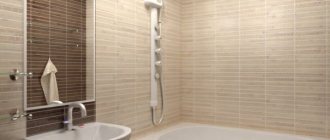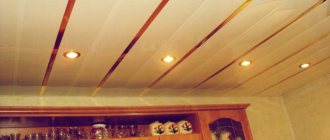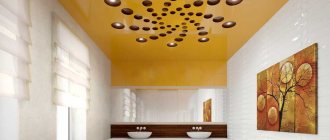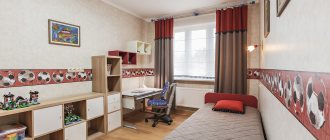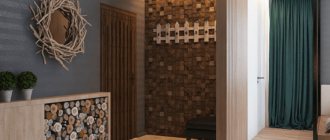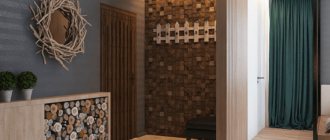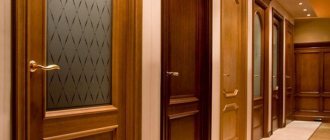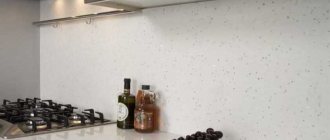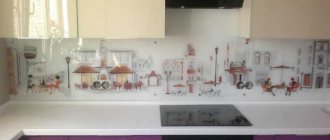Advantages of wallpapering the ceiling
Wallpapering the ceiling is often the most affordable and budget-friendly way to decorate a living space. The undeniable advantages of this material for ceiling surfaces include:
- ease of operation;
- no need for careful leveling of the surface;
- wide choice of texture and color of ceiling wallpaper;
- high speed of finishing work.
Using thick textured wallpaper will hide minor unevenness in the base, so you won’t need to perfectly level the ceiling.
You can choose the material to suit any style and color scheme of the room. It is not difficult to complete the job in one day, even without prior experience of such work.
Repairing a ceiling with wallpaper will not require the purchase of special equipment and tools. The use of wallpaper suitable for painting will facilitate subsequent renovation of the room.
The disadvantages of ceiling wallpaper include a limited service life, as well as the unsuitability of this finishing option for rooms with high humidity. In the bathroom and kitchen, ordinary paper wallpaper quickly begins to peel off and peel.
Pros and cons of using
Pros:
- environmental friendliness
- practicality
- basic care
- excellent soundproofing qualities
- breathable surface effect
- help brighten up uneven ceilings
Minuses:
- There is still a limited selection of textures and colors
- higher cost compared to conventional wallpaper
- possible accumulation of dust on a particularly textured surface
- Drying time (2-3 days)
Features of choosing ceiling wallpaper
A competent approach to carrying out repair work involves studying the technical features of the varieties of ceiling wallpaper. Photos of wallpaper on the ceiling will give you a clear idea of how different textures look. When choosing, be sure to take into account the overall design style of the room, as well as the color scheme of the room.
Experts recommend choosing a glossy texture and light-colored wallpaper for the ceiling for rooms with limited space. This will help visually enlarge the room. Thick wallpaper with a deep relief pattern will help hide small flaws in the ceiling surface.
When choosing, it is useful to read the information from the manufacturer located on the label of each roll. It contains the characteristics of the material, its composition, as well as recommendations for working with the material.
- It is necessary to calculate the amount of material in order to immediately purchase wallpaper from one batch. The calculations must include a small margin for adjusting the pattern.
- Paper wallpaper is appropriate for a living room, nursery or bedroom. For the kitchen, hallway, bathroom or bathroom, it is recommended to choose moisture-resistant wallpaper.
- The width of the wallpaper for the ceiling is important. It should be understood that it is more convenient to stick a standard canvas with a width of 50 or 55 cm.
- When choosing glue, it is important to take into account the manufacturer’s recommendations. For each type of finishing material, it is necessary to use a specially designed adhesive composition.
Preparing the premises
Vinyl wallpaper is a demanding finishing material, when working with which it is important to withstand harsh temperature and humidity conditions.
- When gluing vinyl strips, you must act quickly, so it is better to completely empty the room of furniture.
- Then maintain the optimal temperature for working with vinyl (22–25 °C) indoors for 24 hours.
- Before you start pasting, you need to turn off the power to the room.
Advice. If the room is too hot and dry, this will disrupt the drying mode of the coating. Containers of water placed in the corners will help to humidify the air, and during the heating season - wet towels on radiators.
Calculation of wallpaper consumption on the ceiling
When calculating material consumption, it is necessary to carefully measure the length and width of the room. It is not difficult to correctly calculate how many rolls of wallpaper will be needed for the ceiling, knowing the area of the room and the parameters of the roll (length and width).
To determine the number of rolls you need:
- divide the width of the room by the width of the wallpaper;
- Divide the length of the room by the length of the roll.
You should add a margin for adjusting the pattern and some unevenness of the ceiling surface.
How to wallpaper a ceiling
The work of decorating the ceiling is labor-intensive, but does not require special experience or special tools. A competent approach involves dividing it into several stages.
Preparatory stage
It is important to create optimal working conditions:
- dismantle lighting fixtures;
- empty the room of furniture;
- take care of wire insulation;
- close windows to avoid drafts.
An important question is what comes first: the ceiling or the wallpaper on the walls. In the case of wallpapering the ceiling, it is easier to start from the ceiling. Otherwise, there is a high probability of staining the new wallpaper on the walls, raising the stripes to the ceiling.
- The usual practice is to cover the ceiling first, and then the walls, bringing the wallpaper under the ceiling.
- It is more difficult to decide what comes first, wallpaper or suspended ceiling. When gluing walls yourself, it is better to complete the work before installing the suspended ceiling sheet.
- As part of the preparation, you should get rid of the old coating, clean the surface with a spatula, and plaster over cracks and irregularities. It is recommended to treat the ceiling with a primer to make it easier to glue the wallpaper.
Cutting the canvas
- Before gluing wallpaper on the ceiling, be sure to cut the prepared rolls.
- The strips are placed along the walls at right angles to the window opening. With this gluing scheme, the seams will become less noticeable in natural light.
- The length of the walls is carefully measured, the strips are cut with the pattern adjusted and a small allowance.
DIY wallpapering on the ceiling
The adhesive composition is prepared in strict accordance with the instructions. The finished glue is carefully distributed over the surface of the wallpaper using a brush or roller. Particular attention is paid to the edges.
- After applying the adhesive, it is reasonable to wait 10-15 minutes. The glue will saturate the strip of wallpaper.
- At this time, the adhesive composition is applied to the ceiling surface at the location of the wallpaper strip.
- The strip is applied to the ceiling on one side. Pressing, gently smooth with a rubber spatula or a clean roller from the center to the edges. This will remove air bubbles from under the canvas.
- The remaining strips are glued in exactly the same way.
- At the place where the chandelier is attached, a cut is made crosswise.
- After completing the work, the ceiling should dry. You can’t open the windows, a draft will ruin all the work.
It's easy to do the gluing with two people. If you don’t have an assistant, then it makes sense to use non-woven wallpaper; it’s easier to glue them.
